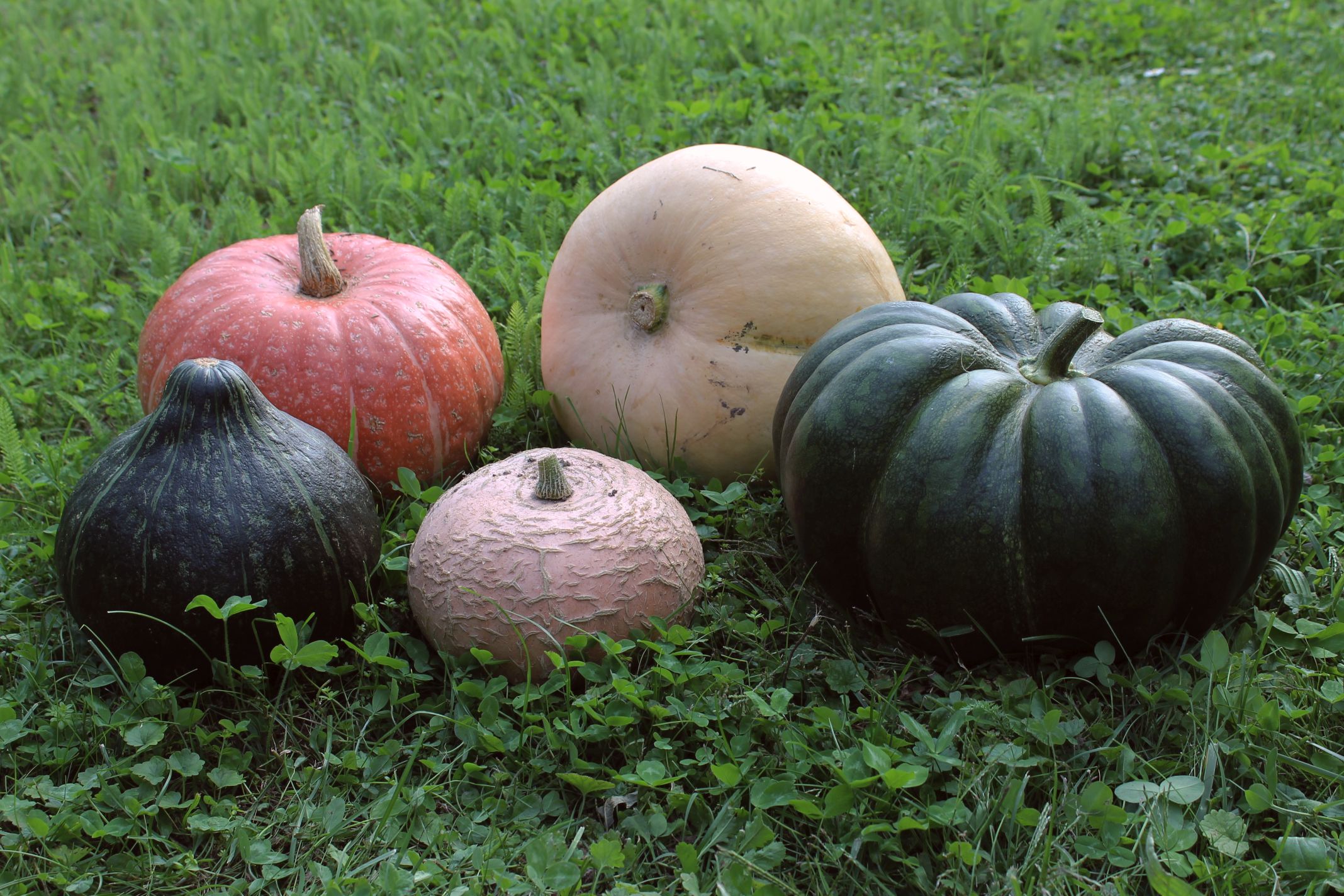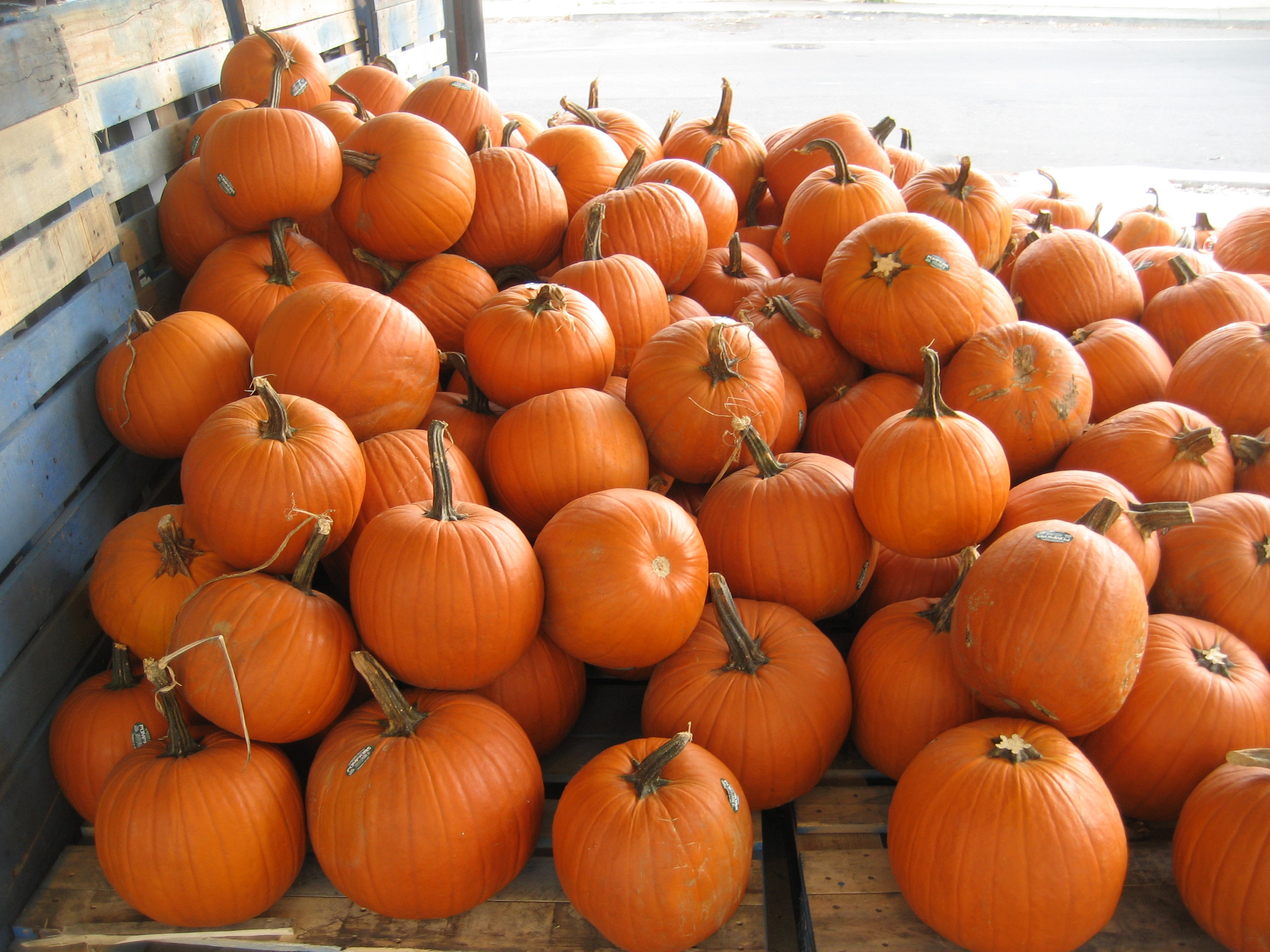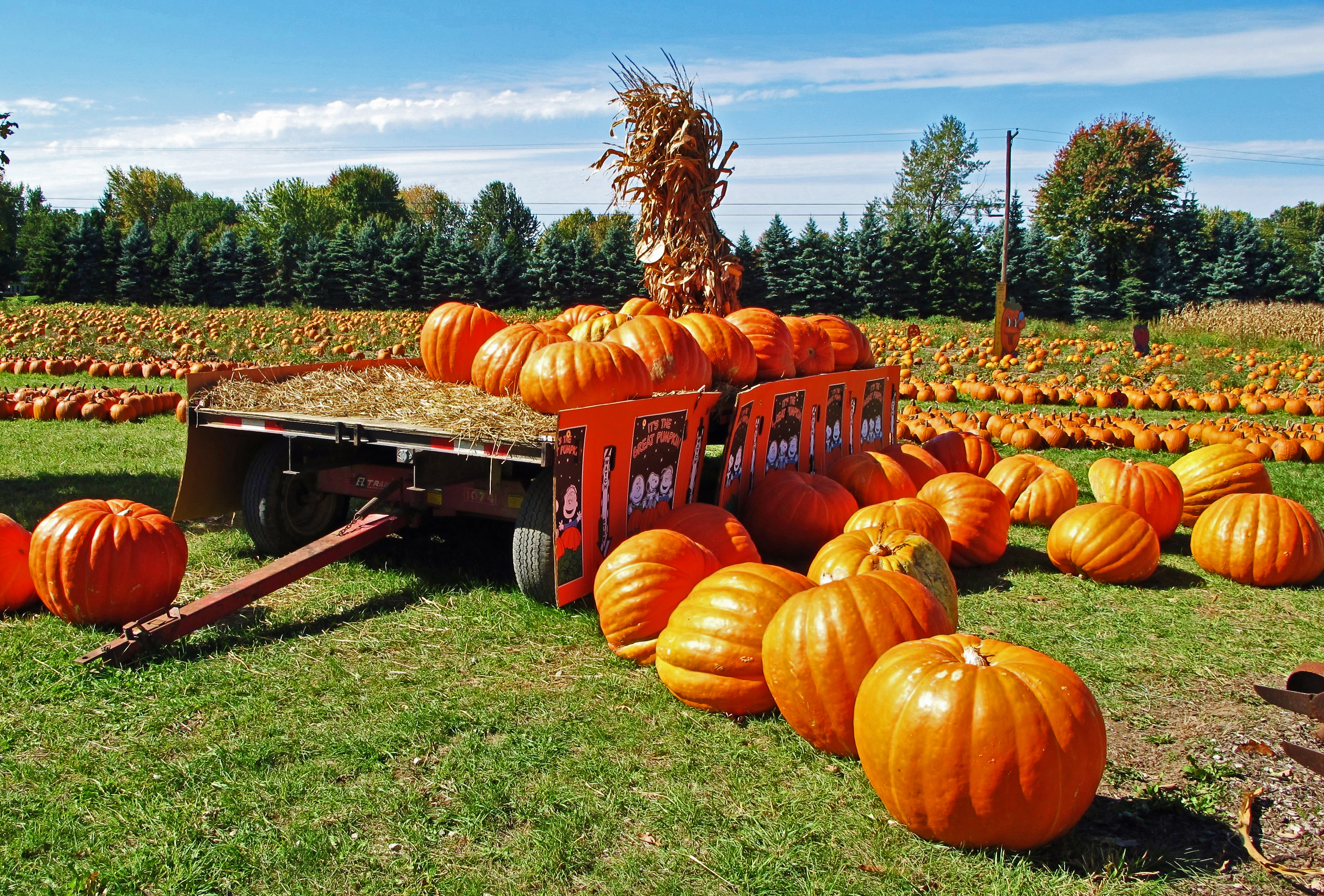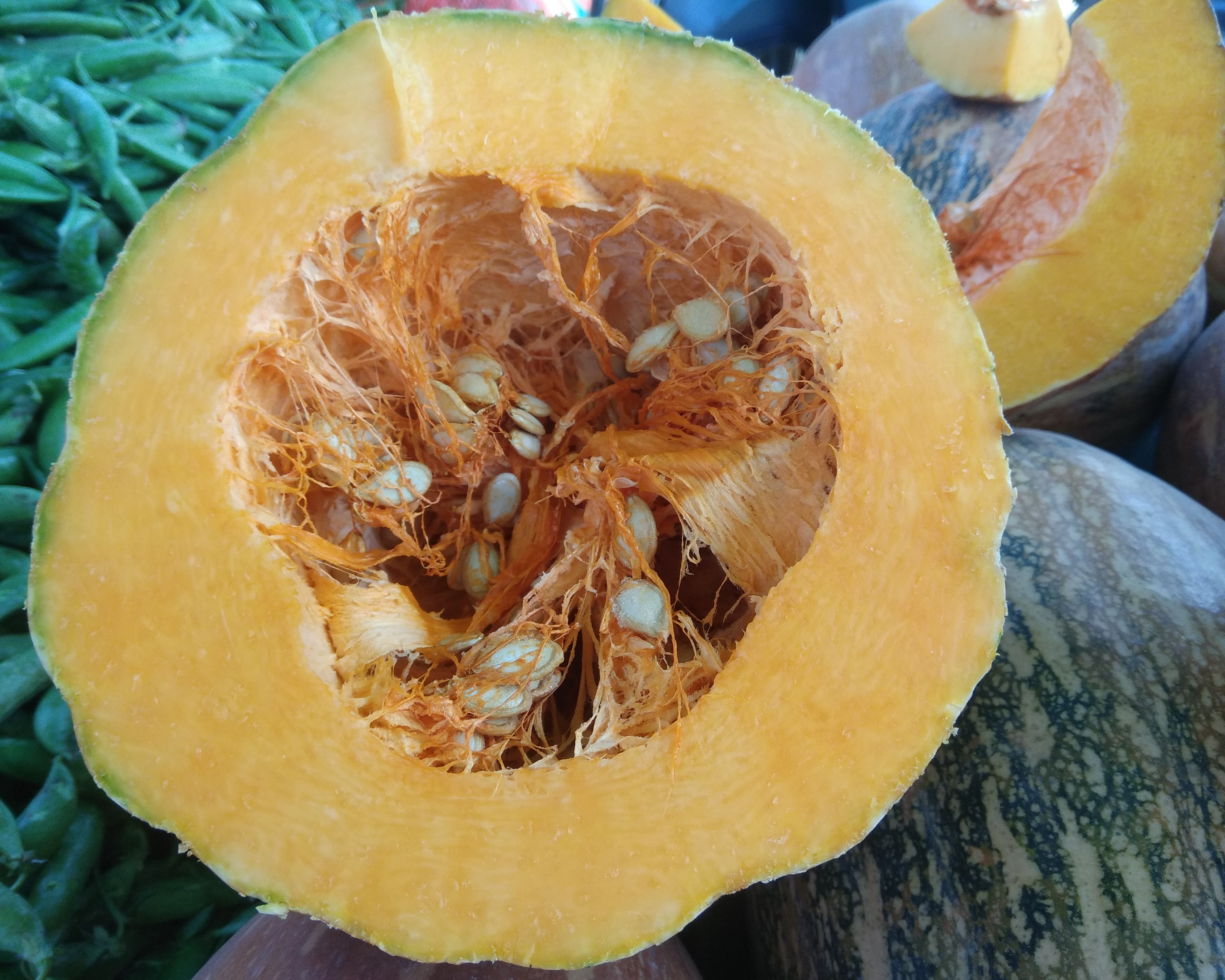Pumpkin on:
[Wikipedia]
[Google]
[Amazon]


 A pumpkin is a
A pumpkin is a
 Pumpkin fruits are a type of botanical berry known as a pepo. Characteristics commonly used to define "pumpkin" include smooth and slightly ribbed skin, and deep yellow to orange color. White, green, and other pumpkin colors also exist.
While '' C. pepo'' pumpkins generally weigh between , Giant pumpkins can exceed a
Pumpkin fruits are a type of botanical berry known as a pepo. Characteristics commonly used to define "pumpkin" include smooth and slightly ribbed skin, and deep yellow to orange color. White, green, and other pumpkin colors also exist.
While '' C. pepo'' pumpkins generally weigh between , Giant pumpkins can exceed a
 As one of the most popular crops in the United States, in 2017 over of pumpkins were produced. The top pumpkin-producing states include
As one of the most popular crops in the United States, in 2017 over of pumpkins were produced. The top pumpkin-producing states include


 A pumpkin is a
A pumpkin is a vernacular
A vernacular or vernacular language is in contrast with a "standard language". It refers to the language or dialect that is spoken by people that are inhabiting a particular country or region. The vernacular is typically the native language, n ...
term for mature winter squash of species and varieties in the genus '' Cucurbita'' that has culinary and cultural significance but no agreed upon botanical or scientific meaning. The term ''pumpkin'' is sometimes used interchangeably with "squash" or "winter squash", and is commonly used for cultivars of '' Cucurbita argyrosperma'', '' Cucurbita ficifolia'', '' Cucurbita maxima'', '' Cucurbita moschata'', and '' Cucurbita pepo''.
Native to North America (northeastern Mexico
Mexico ( Spanish: México), officially the United Mexican States, is a country in the southern portion of North America. It is bordered to the north by the United States; to the south and west by the Pacific Ocean; to the southeast by Guate ...
and the southern United States
The United States of America (U.S.A. or USA), commonly known as the United States (U.S. or US) or America, is a country primarily located in North America. It consists of 50 U.S. state, states, a Washington, D.C., federal district, five ma ...
), ''C. pepo'' pumpkins are one of the oldest domesticated plants, having been used as early as 7,000 to 5,500 BC. Today, pumpkins of varied species are widely grown for food, as well as for aesthetic and recreational purposes. The pumpkin's thick shell contains edible seeds and pulp. Pumpkin pie, for instance, is a traditional part of Thanksgiving
Thanksgiving is a national holiday celebrated on various dates in the United States, Canada, Grenada, Saint Lucia, Liberia, and unofficially in countries like Brazil and Philippines. It is also observed in the Netherlander town of Leiden ...
meals in Canada
Canada is a country in North America. Its ten provinces and three territories extend from the Atlantic Ocean to the Pacific Ocean and northward into the Arctic Ocean, covering over , making it the world's second-largest country by tota ...
and the United States, and pumpkins are frequently carved as jack-o'-lanterns for decoration around Halloween
Halloween or Hallowe'en (less commonly known as Allhalloween, All Hallows' Eve, or All Saints' Eve) is a celebration geography of Halloween, observed in many countries on 31 October, the eve of the Western Christian feast of All Saints' Day. ...
, although commercially canned pumpkin purée and pumpkin pie fillings are usually made of different pumpkin varieties from those used for jack-o'-lanterns.
Etymology and terminology
According to theOxford English Dictionary
The ''Oxford English Dictionary'' (''OED'') is the first and foundational historical dictionary of the English language, published by Oxford University Press (OUP). It traces the historical development of the English language, providing a com ...
, the English word ''pumpkin'' derives from the Ancient Greek
Ancient Greek includes the forms of the Greek language used in ancient Greece and the ancient world from around 1500 BC to 300 BC. It is often roughly divided into the following periods: Mycenaean Greek (), Dark Ages (), the Archaic p ...
word ( romanized ), meaning 'melon'. Under this theory, the term transitioned through the Latin
Latin (, or , ) is a classical language belonging to the Italic branch of the Indo-European languages. Latin was originally a dialect spoken in the lower Tiber area (then known as Latium) around present-day Rome, but through the power ...
word and the Middle French
Middle French (french: moyen français) is a historical division of the French language that covers the period from the 14th to the 16th century. It is a period of transition during which:
* the French language became clearly distinguished from t ...
word to the Early Modern English
Early Modern English or Early New English (sometimes abbreviated EModE, EMnE, or ENE) is the stage of the English language from the beginning of the Tudor period to the English Interregnum and Restoration, or from the transition from Middl ...
, which was changed to ''pumpkin'' by 17th-century English colonists, shortly after encountering pumpkins upon their arrival in what is now the northeastern United States.
An alternate derivation for ''pumpkin'' is the Massachusett word , meaning 'grows forth round'. This term would likely have been used by the Wampanoag people (who speak the dialect of Massachusett) when introducing pumpkins to English Pilgrims at Plymouth Colony, located in present-day Massachusetts
Massachusetts (Massachusett language, Massachusett: ''Muhsachuweesut assachusett writing systems, məhswatʃəwiːsət'' English: , ), officially the Commonwealth of Massachusetts, is the most populous U.S. state, state in the New England ...
. The English word '' squash'' is also derived from a Massachusett word, variously transcribed as , , or, in the closely-related Narragansett language
Narragansett is an Algonquian language formerly spoken in most of what is today Rhode Island by the Narragansett people. It was closely related to the other Algonquian languages of southern New England like Massachusett and Mohegan-Pequot. ...
, .
Researchers have noted that the term pumpkin and related terms like ayote and calabaza are applied to a range of winter squash with varying size and shape. The term ''tropical pumpkin'' is sometimes used for pumpkin cultivars of the species ''Cucurbita moschata''.
Description
 Pumpkin fruits are a type of botanical berry known as a pepo. Characteristics commonly used to define "pumpkin" include smooth and slightly ribbed skin, and deep yellow to orange color. White, green, and other pumpkin colors also exist.
While '' C. pepo'' pumpkins generally weigh between , Giant pumpkins can exceed a
Pumpkin fruits are a type of botanical berry known as a pepo. Characteristics commonly used to define "pumpkin" include smooth and slightly ribbed skin, and deep yellow to orange color. White, green, and other pumpkin colors also exist.
While '' C. pepo'' pumpkins generally weigh between , Giant pumpkins can exceed a tonne
The tonne ( or ; symbol: t) is a unit of mass equal to 1000 kilograms. It is a non-SI unit accepted for use with SI. It is also referred to as a metric ton to distinguish it from the non-metric units of the short ton ( United State ...
in mass. Most are varieties of '' Cucurbita maxima'', and were developed through the efforts of botanical societies and enthusiast farmers. The largest cultivars of the species ''Curcubita maxima'' frequently reach weights of over , with current record weights of over 1,226 kg (2,703 lbs).
History
The oldest evidence of '' Cucurbita pepo'' pumpkin is fragments found inMexico
Mexico ( Spanish: México), officially the United Mexican States, is a country in the southern portion of North America. It is bordered to the north by the United States; to the south and west by the Pacific Ocean; to the southeast by Guate ...
that are dated between 7,000 and 5,500 BC. Within decades after Europeans began colonizing North America, illustrations of pumpkins similar to the modern cultivars Small Sugar pumpkin and Connecticut Field pumpkin were published in Europe.
Cultivation
Pumpkins are a warm-weather crop that is usually planted by early July in the Northern Hemisphere. Pumpkins require that soil temperatures deep are at least and that the soil holds water well. Pumpkin crops may suffer if there is a lack of water, because of temperatures below , or if grown in soils that become waterlogged. Within these conditions, pumpkins are considered hardy, and even if many leaves and portions of the vine are removed or damaged, the plant can quickly grow secondary vines to replace what was removed. Pumpkins produce both a male and female flower, with fertilization usually performed by bees. In America, pumpkins have historically been pollinated by the nativesquash bee
The name squash bee, also squash and gourd bee, is applied to two related genera of bees in the tribe Eucerini; ''Peponapis'' and ''Xenoglossa''. Both genera are oligoleges (pollen specialists) on the plant genus ''Cucurbita'' and closely relate ...
, ''Peponapis pruinosa'', but that bee has declined, probably partly due to pesticide ( imidacloprid) sensitivity. Ground-based bees, such as squash bees and the eastern bumblebee, are better suited to manage the larger pollen particles that pumpkins create. One hive per acre (0.4 hectares, or five hives per 2 hectares) is recommended by the U.S. Department of Agriculture. If there are inadequate bees for pollination, gardeners may have to hand pollinate. Inadequately pollinated pumpkins usually start growing but fail to develop.
Production
In 2020, world production of pumpkins (including squash and gourds) was 28 million tonnes, with China accounting for 27% of the total. Ukraine and Russia each produced about one million tonnes.In the United States
 As one of the most popular crops in the United States, in 2017 over of pumpkins were produced. The top pumpkin-producing states include
As one of the most popular crops in the United States, in 2017 over of pumpkins were produced. The top pumpkin-producing states include Illinois
Illinois ( ) is a state in the Midwestern United States. Its largest metropolitan areas include the Chicago metropolitan area, and the Metro East section, of Greater St. Louis. Other smaller metropolitan areas include, Peoria and Roc ...
, Indiana
Indiana () is a U.S. state in the Midwestern United States. It is the 38th-largest by area and the 17th-most populous of the 50 States. Its capital and largest city is Indianapolis. Indiana was admitted to the United States as the 19th ...
, Ohio
Ohio () is a U.S. state, state in the Midwestern United States, Midwestern region of the United States. Of the List of states and territories of the United States, fifty U.S. states, it is the List of U.S. states and territories by area, 34th-l ...
, Pennsylvania
Pennsylvania (; (Pennsylvania Dutch: )), officially the Commonwealth of Pennsylvania, is a state spanning the Mid-Atlantic, Northeastern, Appalachian, and Great Lakes regions of the United States. It borders Delaware to its southeast, Ma ...
, and California
California is a state in the Western United States, located along the Pacific Coast. With nearly 39.2million residents across a total area of approximately , it is the most populous U.S. state and the 3rd largest by area. It is also the ...
. Pumpkin is the state squash of Texas
Texas (, ; Spanish language, Spanish: ''Texas'', ''Tejas'') is a state in the South Central United States, South Central region of the United States. At 268,596 square miles (695,662 km2), and with more than 29.1 million residents in 2 ...
.
According to the Illinois Department of Agriculture
The Illinois Department of Agriculture is the code department of the Illinois state government that regulates various facets of the agriculture industries of Illinois, oversees Illinois soil and water conservation, supervises the weights and mea ...
, 95% of the U.S. crop intended for processing is grown in Illinois. And 41% of the overall pumpkin crop for all uses originates in the state, more than five times the nearest competitor (California, whose pumpkin industry is centered in the San Joaquin Valley
The San Joaquin Valley ( ; es, Valle de San Joaquín) is the area of the Central Valley of the U.S. state of California that lies south of the Sacramento–San Joaquin River Delta and is drained by the San Joaquin River. It comprises seven ...
), and the majority of that comes from five counties in the central part of the state.